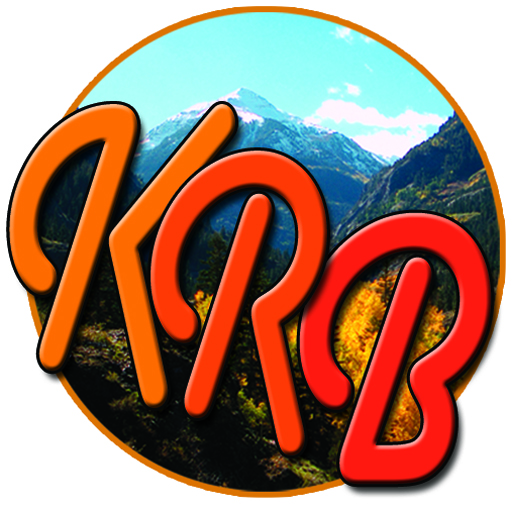Chocolate travels to Europe
Did you know… Chocolate and marshmallow are distant botanical relatives?
Related stories…
| Chocolate–Food of the gods in Mesoamerica | Chocolate — America’s Favorite Sweet Treat |
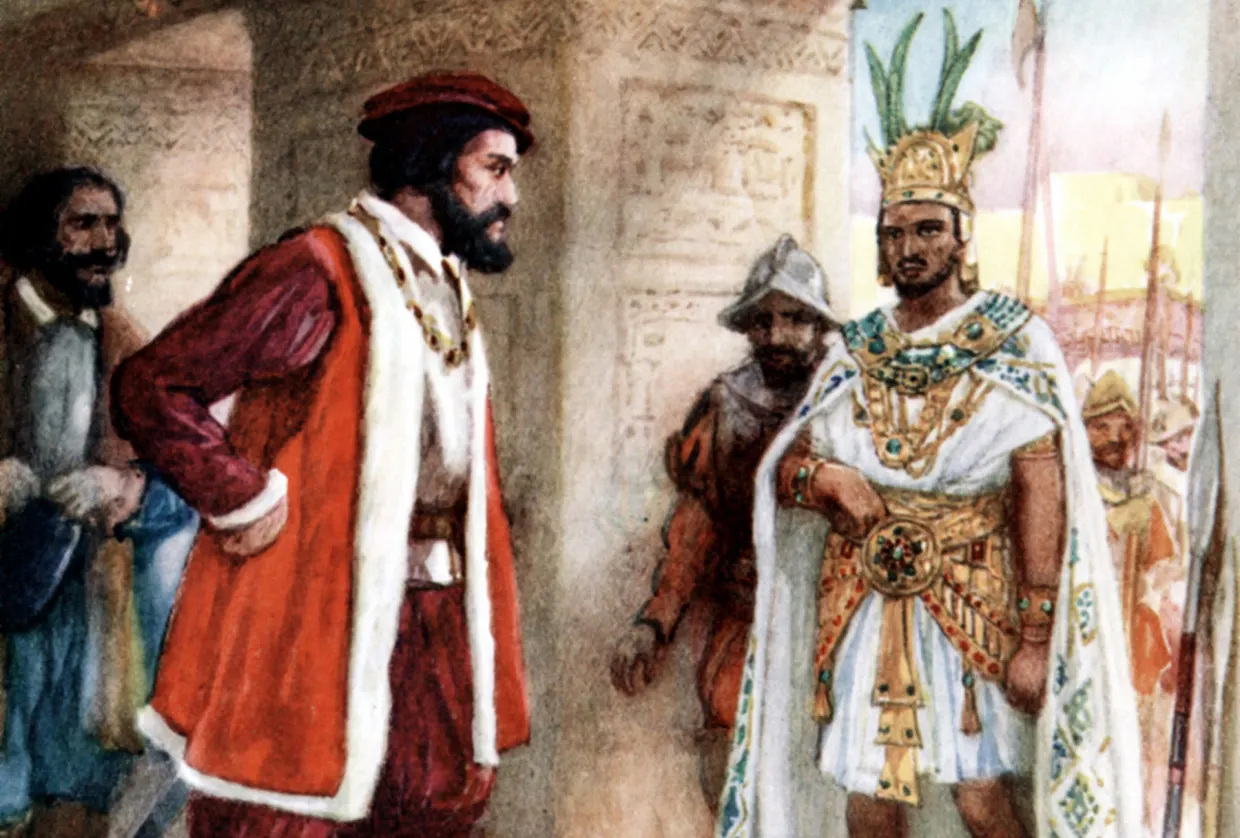
Hernándo Cortés meeting Montezuma II. Undated illustration. Spanish conquistador who conquered Mexico, with Moctezuma II, last Aztec emperor, 1519. History.com / Encyclopedia Britannica. (Public Domain)
[February 6, 2023 | Montrose Mirror | By Kathryn R. Burke]
Did you know? Chocolate and marshmallow are distant botanical relatives. The cacao tree is also related to cotton, hibiscus, and okra. Theobromine, the main ingredient in cacao or chocolate is a stimulant and that has behavioral effects similar to caffeine found in tea and cola.(2) It’s also an aphrodisiac. Cocoa Powder is a powerful antioxidant; it’s a common ingredient in skin cleansers and cosmetics. It’s also considered a health food for that same reason.(4) Theobroma oil, also known as cocoa butter, is a popular moisturizer for people with dark skin, and is often used to diminish stretch marks from pregnancy. Finally, did you know that chocolate has been around for more than 5,300 years?(1, 15)
So, cleanse and beautify your face with it before an amorous interlude where you will consume chocolate. If you wind up pregnant and sleepy afterward, drink chocolate to stay awake and rub cocoa butter on your tummy to get rid of stretch marks. (Cocoa butter also helps with post-surgery scars; sorry guys, it does not cure baldness.) Finally, think of all the exciting, romantic fun you can have (regardless of fertility expectations) making smores and washing them down with hot chocolate. Yum.
Chocolate started out as a bitter drink with the Olmec in Mesoamerica (Central and South America). (They didn’t have sugar.) The Maya considered it a gift from the gods, using the drink for religious celebrations and rituals (like human sacrifices—cutting the living heart, which resembles a cocoa pod, from its victim). The Aztec (further north, in Mexico) considered it more valuable than gold and used it as currency. They also celebrated its stimulant and aphrodisiac effects; their Emperor Montezuma, a large man with large appetites, reportedly drank gallons of it a day.(1) [Read story on chocolate’s origin.]
It all changed with the arrival of the Spanish in 1519. Seeking gold and professing a desire to spread Christianity, Spaniards had sailed from the Caribbean (which they had already plundered). Under the leadership of Hernán Cortés, a force of 600 men landed on the shores of a densely populated area with a society of 21 million people, one of the largest in the world. The Aztec were the largest population, but they were disliked because of high taxation and sacrificial practices. Cortés easily rounded up disgruntled warriors as he advanced on Aztec’s capital, Tenochtitlán. With a population of nearly 300,000, it was one of the largest cities in the world. Cortés had about 1,000 men when he arrived, but it didn’t slow him down, and, unfortunately, the Aztec did not recognize him as an adversary.(8)
Thinking the Spanish might be reincarnated deities or followers of the white-skinned and bearded Teotihuacán god, Quetzalcoatl, the Aztec greeted the invaders as guests, plying them with gifts and chocolate. Cortés and his gang had ulterior motives. Observing that the Aztec people paid their tributes to their emperor with great quantities of cocoa beans, and that Montezuma had over 1,000 million of the valuable beans in his royal coffers(5) Cortés decided to confiscate the beans along with the gold and haul it all back to Spain.
His first attempt failed. His troops regrouped, and one year later, and allied with nearly 200,000 Indigenous warriors from other city-states, they succeeded. Superior weaponry, European technology and war tactics, coupled with diseases brought by the Europeans to which the Indians had no immunity, led to the downfall of the Aztec Empire.(5)
1500s. But cacao not only survived, it prospered, and thanks to the Spanish, made its way to Europe. Initially, it became the drink of kings and aristocrats, much as it had been in Mesoamerica. Stories vary as to who was the first to introduce it. Some accounts point to Christopher Columbus intercepting a trade ship in 1502 and bringing the beans back to Spain. It’s certain that Cortés, brought cacao beans back with him. Realizing the benefits he could reap from it, in 1528 he also brought back the equipment necessary for its preparation. Its reception was enhanced when nuns, working as missionaries in Mexico, started sweetening it with sugar.(7)
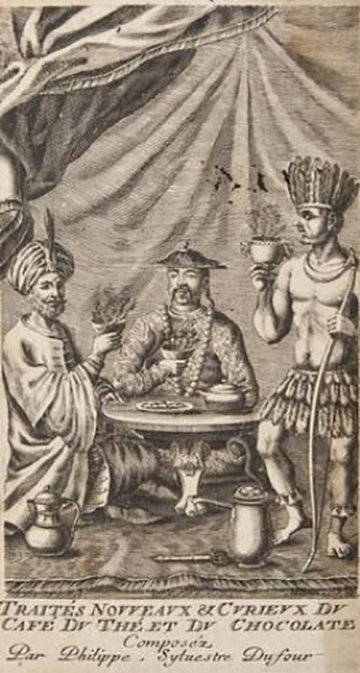
“Traités nouveaux & curieux du café du thé et du chocolate,” by Philippe Sylvestre Dufour, 1685. Frontispiece illustration for “New and curious treatises of coffee, tea and chocolate.” (Public domain.)
It’s more likely that it was the friars brought it in 1544, when they presented Guatemalan Mayans to Philip II of Spain in 1544 and brought cacao beans along as a gift.(1) “By the time chocolate is coming back from New Spain or Mexico, the era of conquistadors was long gone,” says Marcy Norton, author of Sacred Gifts, Profane Pleasures: A History of Tobacco and Chocolate in the Atlantic World. (17)
No matter how chocolate got to Spain, by the late 1500s it was a much-loved indulgence by the Spanish court, and Spain began importing chocolate in 1585. It was expensive to import and prepare, so the elite could afford it. They also believed it had health benefits, so it was considered a necessary beverage; consumption during Lent was even permitted.(7)
** Note: The Spanish pronounce it cho-c0-lat-teh. They don’t say cacao because “caca” means poop in Spanish. Might be the same color, but definitely not the same thing.
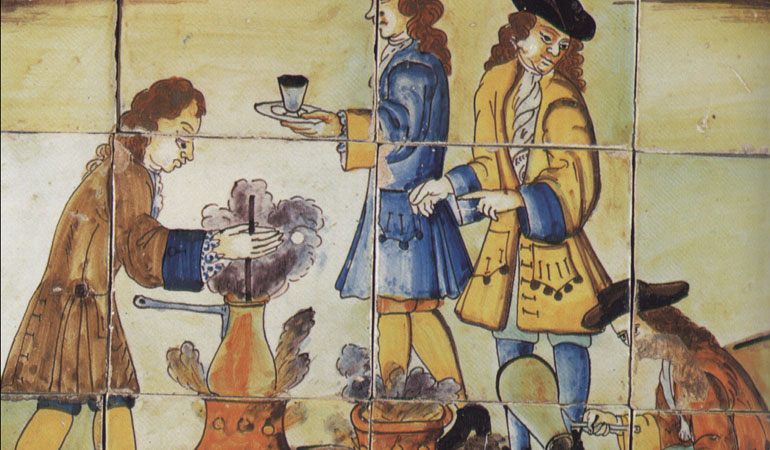
Spanish tile. This picture shows the first chocolate makers in Spain making the famous drink. (Public domain)
1600s. The Spanish kept chocolate somewhat of a secret, but the word got out. Soon, trading ships from other countries began transporting it back home for production. It was introduced to France in 1615, when Ana Maria Mauricia, daughter of Spanish king Phillip III, married Louis XIII and brought the drink with her.(7)
As other Europeans tasted and enjoyed it, the use of chocolate spread. Along the way, the bitter taste disappeared as Europeans began making their own versions adding cane sugar, cinnamon, and other spices and flavorings to the beverage, usually served hot.
The first known English recipe for chocolate called for sugar, long red pepper, cloves, aniseed, almonds, nuts, orange flower water, and, of course, cacao. “The hotter it is drunke, the better it is,” said the recipe’s author in 1652. Unaware of the Aztec custom of drinking it cool, the recipe said that “being cold it may doe harm.”(15)
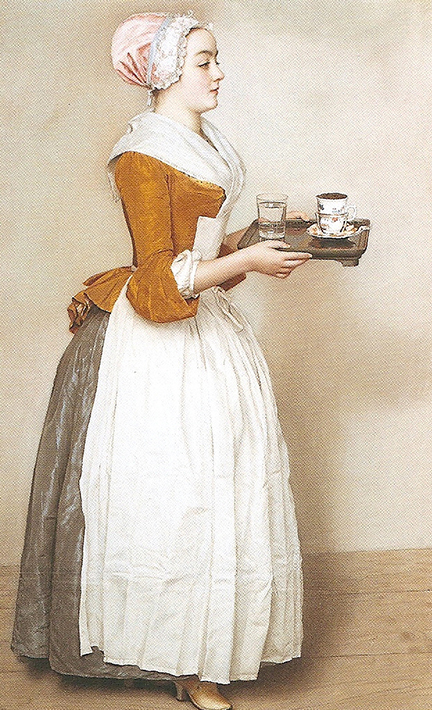
“La Belle Chocolatiere” (The Chocolate Girl). Pastel on Parchment. Jean-Étienne Liotard. circa 1743. (Public domain)

La tasse de chocolat. (1768) Jean-Baptiste Charpentier. The painting is of the family of the Duke of Penthièvre drinking chocolate and communicates the social significance of chocolate in early France, and signifies the family’s wealth and status. (Public Domain)
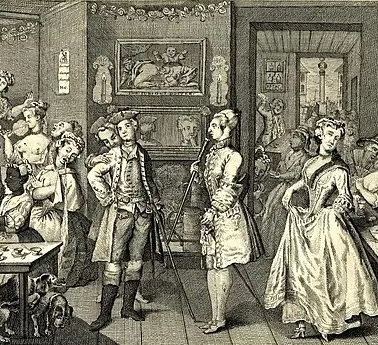
“The Rake’s Rendezvous: Or the Midnight Revels” Tom King’s Coffee House, Covent Gardens. London. c1685. CocoaRunners. (Image cropped.)
Britain opened its first chocolate house in 1657. Soon, fashionable chocolate houses for the wealthy cropped up throughout London, Amsterdam, and other European cities.(6)
According to an article in Cocoa Runners: Coffee and chocolate houses were a far cry from modern cafes. Instead of hosting young professionals working at laptops, these establishments were known for anarchy and licentiousness. Chocolate houses were a hotbed of gambling and sedition: they were places where people gathered to talk politics and share forbidden ideas. One famous chocolate house, Cocoa Tree Coffee House, had an underground tunnel to take plotters and traitors safely out of the premises. Alarmed at the unrest fomenting in coffee shops, Charles II put out an edict in 1675 banning public houses from selling coffee, tea, or chocolate. The new law encountered massive popular resistance and, to chocolate-drinkers’ delight, was rescinded after only a few weeks. Perhaps the law’s case was weakened by the fact that Ozdina’s chocolate house on St James’s Street was a favourite haunt of the King and his mistresses! (18)
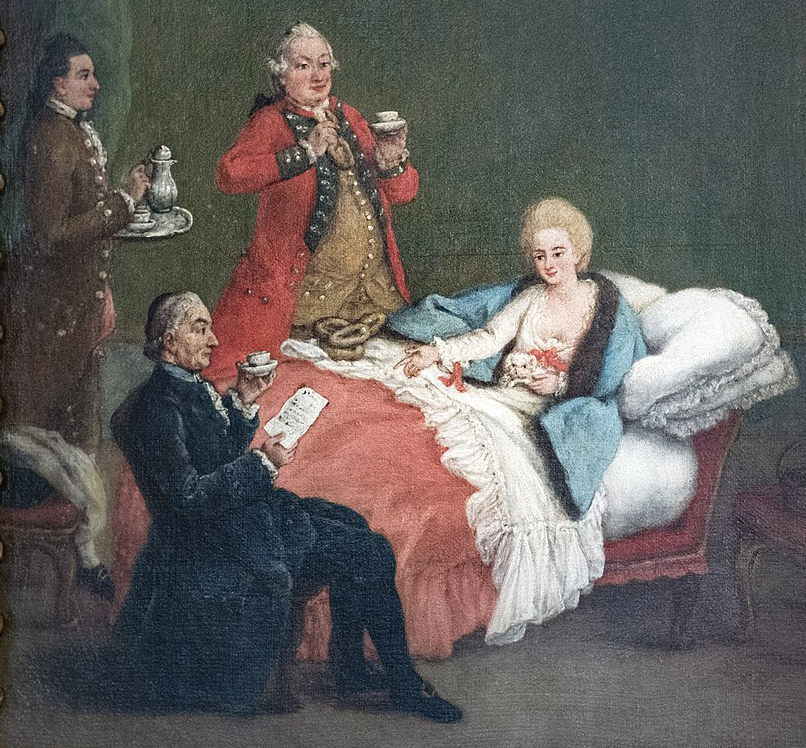
“Ca’ Rezzonico L ciocolata del mattino.” (The Morning Chocolate) (between 1775 and 1780), by Pietro Longhi. Oil on canvas. (Wikipedia. Public Domain.)
Chocolate became so popular, its consumption inspired a “chocomania.”(7) More expensive than tea or coffee, it remained a fashionable luxury drink. It was made in a special chocolate pot with a molinet for frothing. In France, they were even called commodités de conversation, as they would create a convivial atmosphere in parlours when drinking chocolate was offered on social occasions. A spill-proof cup was developed so that “none of the precious liquid would be lost, and ladies dresses were not at risk.”(7)

Chocolatière (chocolate pot). Used to froth up chocolate drinks and is believed to be a late 17th century French invention. Used mainly by nobility, hence made of gold or silver (like this one).
Chocolate also made the trip back across the ocean in the 1600s, arriving in the “colonies” (United States) around 1642. Although evidence suggests that Indigenous peoples of South and Central America had traded it with the Ancestral Pueblo and other groups in North America. [See story]
1700s. Cocoa also retained its reputation as an Aztec aphrodisiac and many people associated chocolate with exquisite pleasure. In 1702, a doctor wrote that, “Chocolate’s properties are such that they stimulate Venus’ ardour.” This explains why, for a long time, this beverage was considered appropriate for adults only.(6) Giacomo Girolamo Casanova, one of the most infamous users of chocolate in the 1700s, thrived in the pleasure capitals of Europe and is reported to have made his first sexual conquest at age 11. He became so well-known for his often complicated and elaborate affairs with women that his name is now synonymous with “womanizer.”(9)
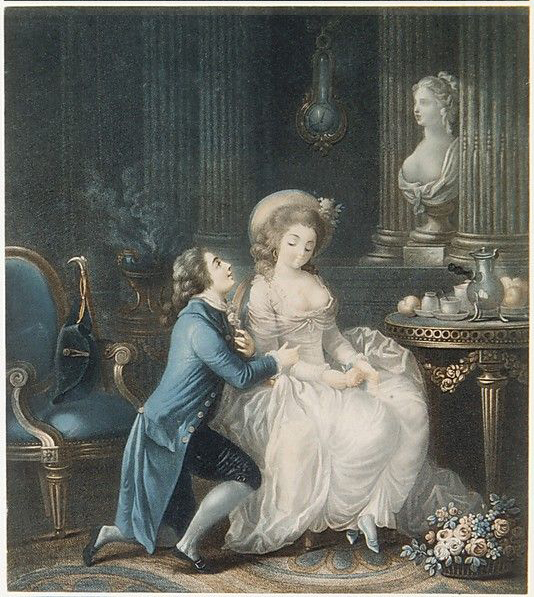
“The Proposal “(1736-93). Louis Marin Bonnet. Chocolate was associated with love and sex in France It was well known throughout Europe that chocolate was an aphrodisiac, and both men and women often gifted chocolate to their lovers for this reason. Note the silver chocolatière on the table to the right of the lady. (Public domain)
Regardless of its use and where consumed, the basic ingredients remained the same: cocoa paste, water, and sugar, usually drunk hot. Different cultures added their own seasonings. Italy added lemon zest, vanilla, jasmine, and ambergris. The British sometimes replaced the water with milk. Or wine (more fun for sure). Besides being considered a romantic stimulant, it also had other medical purposes and could be prescribed, for example, by infusing it with cloves for digestive problems or adding amber for fatigue. The Spanish sometimes added Agave syrup instead of sugar. If the cocoa was too rich, its negative effects could be counterbalanced by vanilla or cinnamon. Innumerable combinations were created to cater for different tastes and preferences.(7)
In 1729, the first mechanical cocoa grinder was invented in Bristol, England by Walter Churchman. Until then, purveyors of chocolate were still using the old and-grinding method, which resulted in a somewhat gritty beverage. The patent for a chocolate refining process was later bought in 1761 by Joseph Fry who started the company that was to become J. S. Fry & Sons.(10)
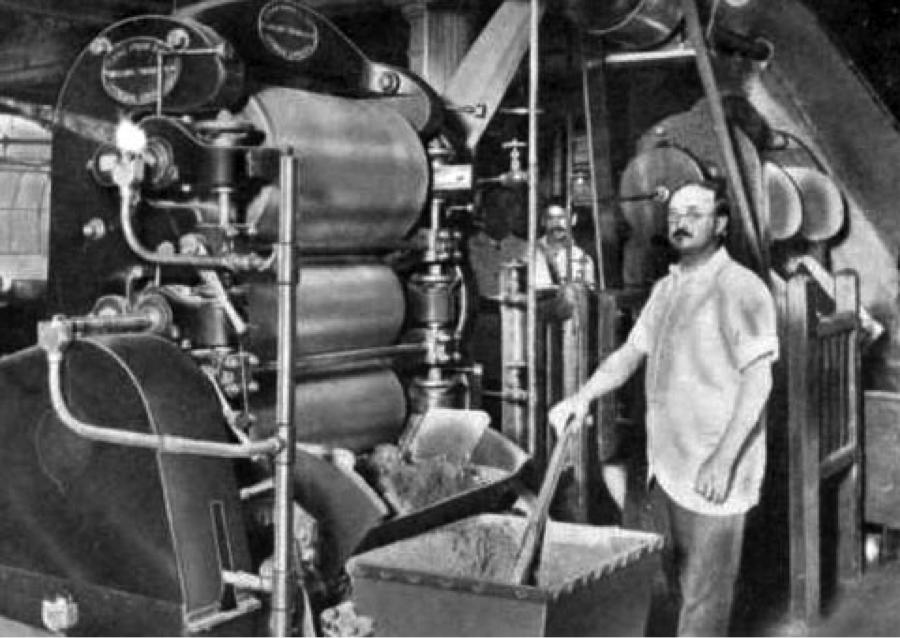
Industrial machine for refining chocolate. Technologies like these helped chocolate spread to lower income classes. A French man by the name of Dubuisson created the steam driven chocolate mill which helped in mass producing chocolate quickly and cost efficiently. (J.S. Fry & Sons)
1800s. The Industrial Revolution led to improved methods for chocolate production and was when it became available in a solid form. 1815, Dutch chemist Coenraad van Houten introduced alkaline salts to chocolate, which reduced its bitterness. In 1828, he discovered a way to treat cacao beans with alkaline salts to make a powdered chocolate that was easier to mix with water. The process became known as “Dutch processing” and the chocolate produced called cacao powder or “Dutch cocoa. The invention of the cocoa press, which separated cocoa butter from roasted cocoa beans, made it easier and cheaper to process cocoa powder.(1)
Throughout the 1800s, chocolate was enjoyed as a beverage, often adding milk instead of water. In 1847, British chocolatier J.S. Fry and Sons created the first chocolate bar molded from a paste made of sugar, chocolate liquor and cocoa butter. In 1876, Swiss chocolatier Daniel added dried milk. A few years later, he and his friend, Henri Nestlé, formed the Nestlé, Company, marketing milk chocolate. In 1879, the texture and taste of Chocolate was further improved when Rodolphe Lindt invented the conching machine in 1879. (1, 10, 12)
Collectively, these discoveries and inventions made it possible to mass produce chocolate that was affordable for everyone.
Then, as today, besides supporting socialization, chocolate was presumed to have special food qualities to maintain health and vitality and stimulate libido. It was, and still is, a popular drink in both around the world, often as a breakfast beverage, but served throughout the day and enjoyed by all classes. (Think of our coffee cafés today…not all that much different…well, except for Internet.) We also consider chocolate a gift expressing (or encouraging) love and romance, especially during Valentine season in February. [Related stories, San Juan Silver Stage.] But any time of the day, any day of the year, chocolate (in its more modern forms) is a sweet treat, a happy food, to be shared, enjoyed, and welcomed by all, regardless of age or location.
(Just reading all this… makes you want to run out and buy some chocolate cake or a handful of candy bars, doesn’t it? Or maybe do a quick drive-by at your favorite coffee house?)
Sources
- 1) “History of chocolate.” history.com.
https://www.history.com/topics/ancient-americas/history-of-chocolate - 2) “About the Cacao tree.” chocolate.org
https://www.chocolate.org/blogs/chocolate-blog/about-the-cacao-tree - 3) The True History of Chocolate.Sophie D. Coe and Michael D. Coe
- 4 ) “Why use chocolate in skin care?” dermascope.com
https://www.dermascope.com/scope-this/why-use-chocolate-in-skin-care - 5) “What textbooks have to say about the conquest of Mexico.” American Historical Assoc.
https://www.historians.org/teaching-and-learning/teaching-resources-for-historians/teaching-and-learning-in-the-digital-age/the-history-of-the-americas/the-conquest-of-mexico/for-students/what-the-textbooks-have-to-say-about-the-conquest-of-mexico#:~:text=In%201519%20Hernan%20Cort%C3%A9s%20(1485,1520)%2C%20the%20Aztec%20emperor. - 6) “Chocolate arrives in Europe.” history.com
https://www.history.com/topics/ancient-americas/history-of-chocolate - 7) “Chocolate in Europe.”alimentarium.org
https://www.alimentarium.org/en/fact-sheet/chocolate-europe - 8) “How Hernán Cortés Conquered the Aztec Empire.” By Karen Juanita Carrillo. History.com.
https://www.history.com/news/hernan-cortes-conquered-aztec-empire - 9) “Who was Cassinova?” Amanda Bensen. (March 1, 2008) Smithsonian Magazine
https://www.smithsonianmag.com/travel/who-was-casanova-160003650/ - 10) History of chocolate.Wikipedia
https://en.wikipedia.org/wiki/History_of_chocolate - 11) Chocolate Wars. The 150-Year Rivalry Between the World’s Greatest Chocolate Makers. Deborah Cadbury. Public Affairs. (2010)
- 12) Conching. https://en.wikipedia.org/wiki/Conching
- 13) “Xocoatl cold.” Maya at Mexico Here. (https://www.mexicolore.co.uk/maya/chocolate/cold-xocoatl)
- 14) “How Maya and Aztec Chocolate Was Prepared.” Maya at Mexicohere.
https://www.mexicolore.co.uk/maya/chocolate/aztec-and-maya-chocolate - 15) “Cup of Hot Chocolate, S’good for What Ails Ya.” Colonial Williamsburg. Mary Miley Theobald. (Winter 2012)
https://research.colonialwilliamsburg.org/foundation/journal/winter12/chocolate.cfm - 16) “The Bittersweet History of Chocolate” Time Magazine. Olivia B. Waxman. (March10, 2017). https://time.com/4693048/chocolate-history-museum/
- 17) “Sacred Gifts, Profane Pleasures: A History of Tobacco and Chocolate in the Atlantic World.” Marcy Norton. Cornell University Press. August 2008
- 18) “History and Culture (of Chocolate)” Cocoa Runners. https://cocoarunners.com/history-and-culture/#h-chocolate-in-america-back-to-the-new-world
Glossary
cacao. Comes from the Mayan words “Ka’kau” meaning “heart blood,” and “Chokola’j” meaning “to drink together.
Chocolate Houses. The Rambunctious, Elitist Chocolate Houses of 18th-Century London were the original gentlemen’s clubs.
chocolatière. (chocolate pot) Used to froth up chocolate drinks and is believed to be a late 17th century French invention. Used mainly by nobility, hence made of gold or silver and a sign of wealth. Also called commodités de conversation, as they would create a convivial atmosphere in parlours when drinking chocolate was offered on social occasions.
chocolhaa (“bitter water”). Mayan name for chocolate.
Conching. Process used in the manufacture of chocolate whereby a surface scraping mixer and agitator, known as a conche, evenly distributes cocoa butter within chocolate and may act as a “polisher” of the particles. It also promotes flavor development through frictional heat, release of volatiles and acids, and oxidation. The name arises from the shape of the vessels initially used which resembled conch shells.
Hernán Cortés (c. 1485-1547). Best known for conquering the Aztecs and claiming Mexico on behalf of Spain. He also became the governor of New Spain.
Industrial Revolution. Transition to new manufacturing processes in Great Britain, continental Europe, and the United States, that occurred during the period from around 1760 to about 1820–1840, This transition included going from hand production methods to machines.
ka’kau. Mayan name for chocolate bean and means heart blood. It is also the origin of our word, cacao.
Mesoamerica. Historic regions of Central and South America dating back as early as 21,000 BCE and populated by indigenous cultures including the Olmec, Zapotec, Maya, Toltec, and Aztec peoples that developed prior to Spanish exploration and conquest in the 16th century. In the organization of its kingdoms and empires, the sophistication of its monuments and cities, and the extent and refinement of its intellectual accomplishments, the the Mesoamerican civilization, along with the comparable Andean civilization farther south, constitutes a New World counterpart to those of ancient Egypt, Mesopotamia, and China. Today the area encompasses northern Costa Rica, Nicaragua, Honduras, El Salvador, Guatemala, Belize, and central to southern Mexico.
Montezuma II. Moctezuma Xocoyotzin (c. 1466 – 29 June 1520). Ninth Emperor of the Aztec Empire (also known as Mexica Empire), reigning from 1502 or 1503 to 1520, when he was killed during the Spanish invasion. Questions remain as to who killed him—his own people or the invaders.
molinet. device on top of chocolate pot to froth up the hot beverage.
Olmec. One of the earliest known civilizations of Mesoamerica.
Tenochtitlan. Aztec capital home to ruler Montezuma II. Located near today’s Mexico City, had between 200,000 and 300,000 inhabitants at its height, and was the most densely populated city ever to exist in Mesoamerica. At that time, it was the largest city in the world.
trembleuse. Special spill-proof cup so that not a drop of the precious beverage was lost and that ladies’ dresses were not at risk. Called mancerina cups in Spain, after their inventor, the Marquis of Mancera.
xocolatl. Aztec name for chocolate. In the form of a metaphor: yollotl, eztli means “heart and blood.” The cacao pod (which looks somewhat like a human heart) was sometimes used symbolically by the Mexica to represent the sacrificed human heart. (https://www.mexicolore.co.uk/maya/chocolate/cold-xocoatl)
